A look at Empires and Tribes’ Early Access offering
It’s often a point of sadness in city-building games that you can’t easily get down from your god-like perspective and take a walk around whatever you’ve just spent ages building. In Empires and Tribes, be sad no more: you spend most of the time on the ground with your people, seeing buildings rise up around you and even helping to build them yourself.
Empires and Tribes is an early-access title which became available on Steam early this year. In it, you play as the mayor of a new village, eventually to become a town, city, or whatever you make of it. While the current introduction made us a little dubious to start with — the UI is a little janky at the moment, so the initial dialogue raised eyebrows — we soon warmed to it. Let’s dive into exactly what makes Empires and Tribes such an appealing concept.
When you begin your city-building adventure, it’s with both feet planted firmly on the ground. After admiring the view from that angle, entering building mode takes you into an aerial view, which is where you get to worry about the big questions: like layout, proximity to amenities and oh-whoops-I-need-to-demolish-my-church-to-build-a-quarry moments. In its present state, the placement is functional at best and takes some getting used to, particularly with roads. Unlike recent titles Foundation and The Universim, Empires and Tribes doesn’t place streets automatically. If you don’t realise this to begin with, and forget it as you go along, you can end up building so close together that you can’t fit a street anymore. It makes sense, but it’s also a shame that you can’t squeeze haphazard bits of street down tiny gaps like medieval city planners definitely would when they inevitably didn’t plan too far ahead.
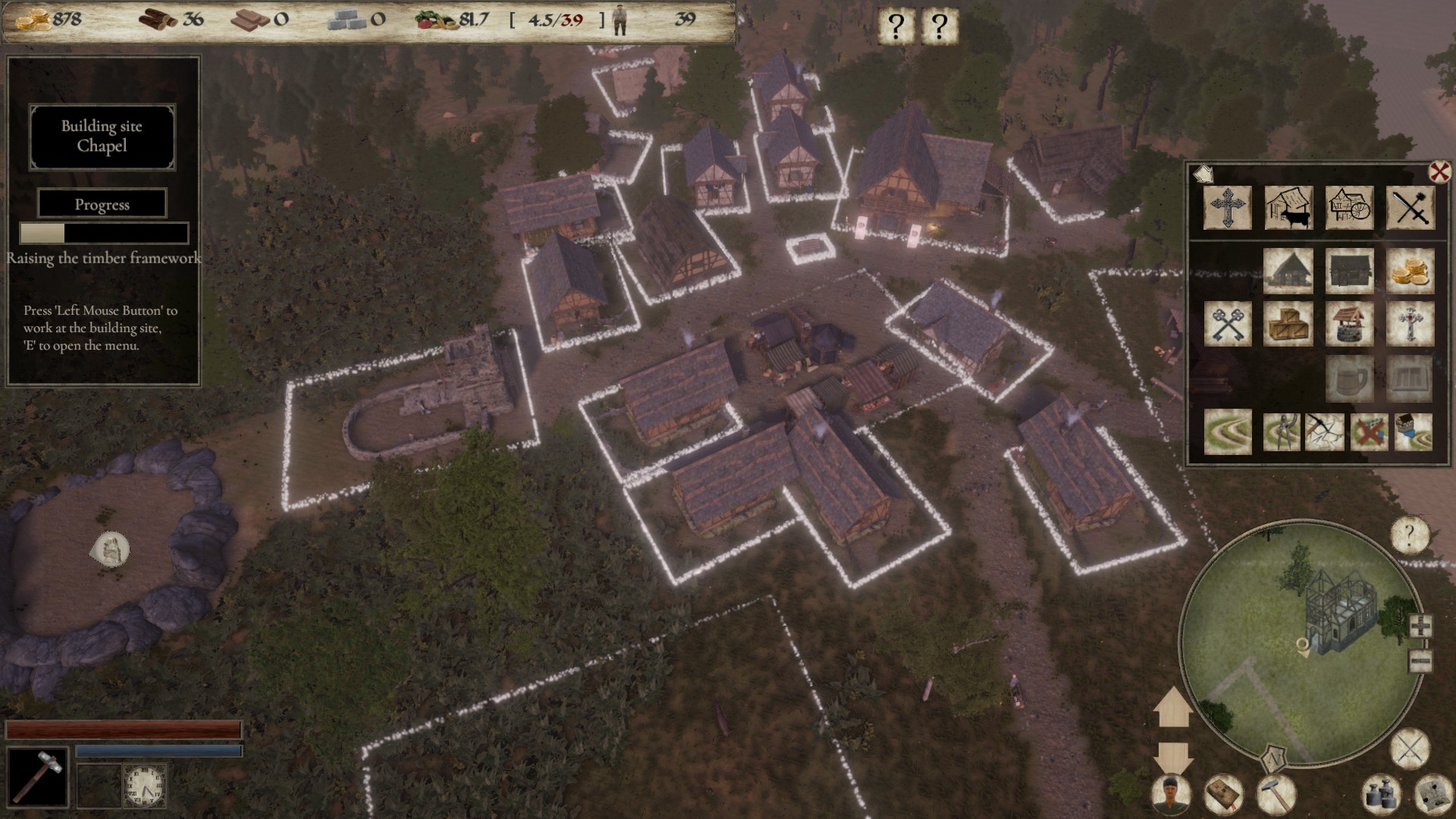
Once you’re rolling, though, it’s pretty good. Aesthetically, it’s great to place the blueprints and watch it all rise from the dirt into a picturesque little market square. You can get as involved in the process as you like. You can rush to the nearest storage (the guild hall, if you’ve just started), pick up some logs and haul them to the build site yourself, or you can watch your builders do it for you. You can sit in your bedroom window watching the walls come up and your builders put the roof on, or you can pick up a hammer yourself and get stuck in. (Hint: Doing it yourself is faster, particularly at night. If you go without sleep too long, however, your vision goes blurry and seeing the hammer in your hand becomes a problem. Go to sleep. Don’t bop a peasant on the head.)
Your first tasks are to get production rolling and get roofs over people’s heads. This means a house tucked next to a market square; a lumber yard, which will be your most important building going forwards; a clay pit; and a hunting ground, where ladies mill around poking things with pointy sticks. You can speak to any of the villagers and tradespeople as you do, but besides a few quests, they won’t have a great deal to say. Quests can keep you occupied, but they don’t seem to do much else – I gave up accepting them from the noticeboard after I got fed up navigating around the markers on the map, which is zoomed in really far and can’t be zoomed out.
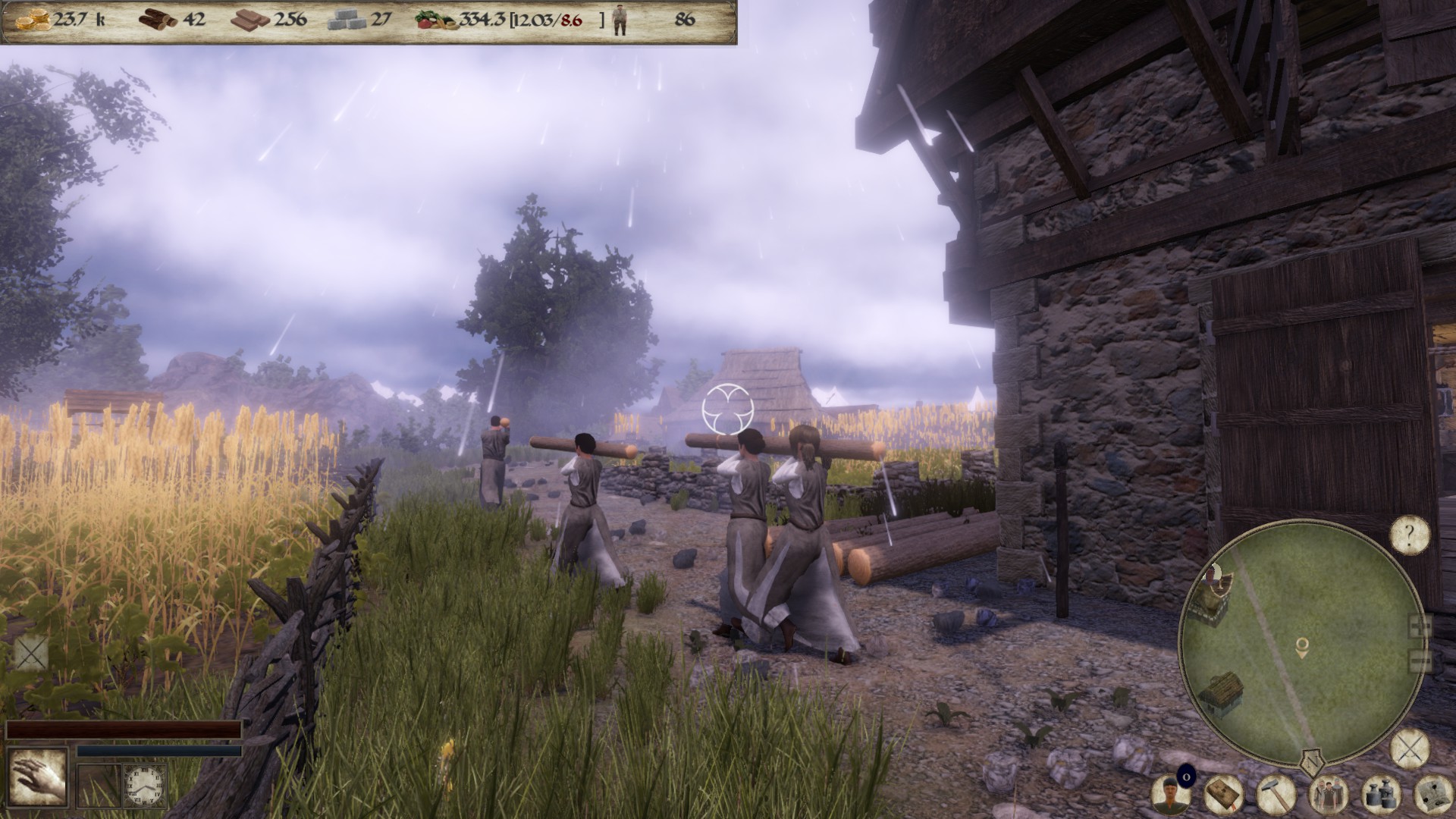
In any case, it’s pretty cool that you could walk around inside all the buildings you make, as well. This extends to using their facilities yourself — buildings you unlock later like the forge and the carpentry let you craft different items at each workbench. For the most part, though, work is done by the workers. You can assign people to each workplace via a series of menus (or by walking up to the building in question), which is the same interface you use to upgrade the buildings later on.
Workers in place, resources start accumulating at workplaces, and that’s where the first logistical hurdle crops up: someone needs to take it somewhere. Your guild hall, along with every storage building you place, comes with one or more merchant carts to collect goods and take them back to storage. Before research, these are incredibly slow, so it takes a bit of fiddling to reduce bottlenecks. And while you could do it all yourself, your limited carry weight means you’d be running between buildings all day just to get things sorted. If you don’t, you end up with production stalling, unable to get resources together fast enough for you to build your next big part of the grand design. Wood, with its high weight, is the nightmare here.
Wait, but you’re the mayor, right? You should probably be getting involved in all the political business of running the town. Nightly council meetings give you this option, but the motivation for getting involved isn’t there just yet. Your council members will raise points from the agenda and each take a side but, while you can try to influence their decisions, any impact on the daily life of your town either isn’t implemented or isn’t clear. The influence UI that pops up during these meetings isn’t very intuitive either, which doesn’t help.
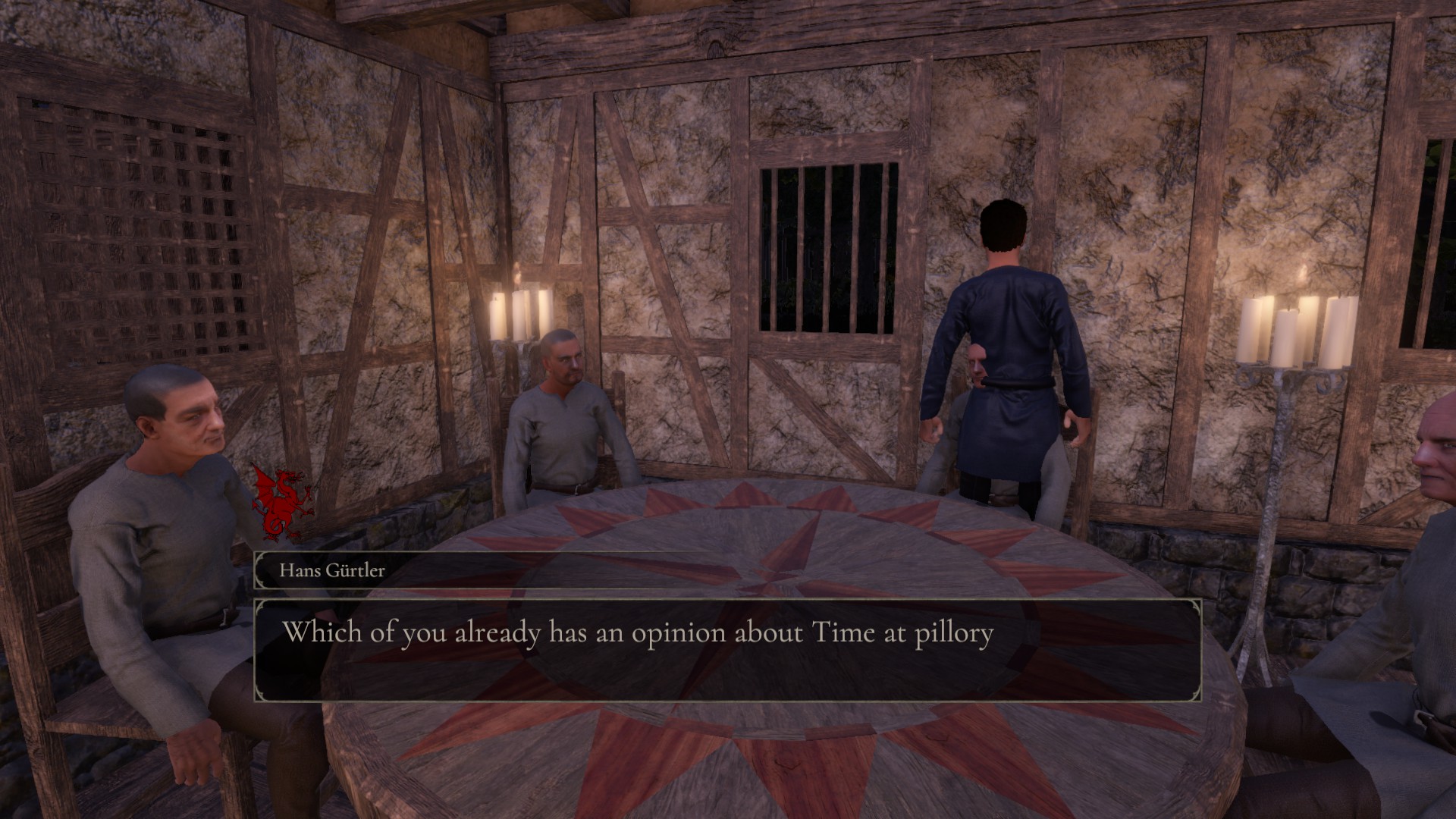
Better then to talk to the priest, whose conversation options at least have clear outcomes. As soon as you build a chapel, you get a priest, and he comes with all the baggage of religious politics. Every now and then he’ll ask your opinion on something and you can make a decision. Again, the impact isn’t obvious yet, but these conversations have felt the most in-role so far
One aspect of religion does become your friend, of course: monks. Occasionally, mendicant monks arrive asking to join you. If you let them in (I have so many now that I honestly wonder how they all fit in the monastery at night — celibate sandwich, anyone?), they boost your research speed, and research can net you pretty cool things like storage capacity increases and cart speed improvements.
At some point — led along by the tutorial’s advice — you will have enough buildings in close enough proximity to your houses that you can think about getting some upgrades. Upgrading production buildings is always a good start, as they open up more slots to add workers, which is vital for food production where you need to maintain a consistent supply.
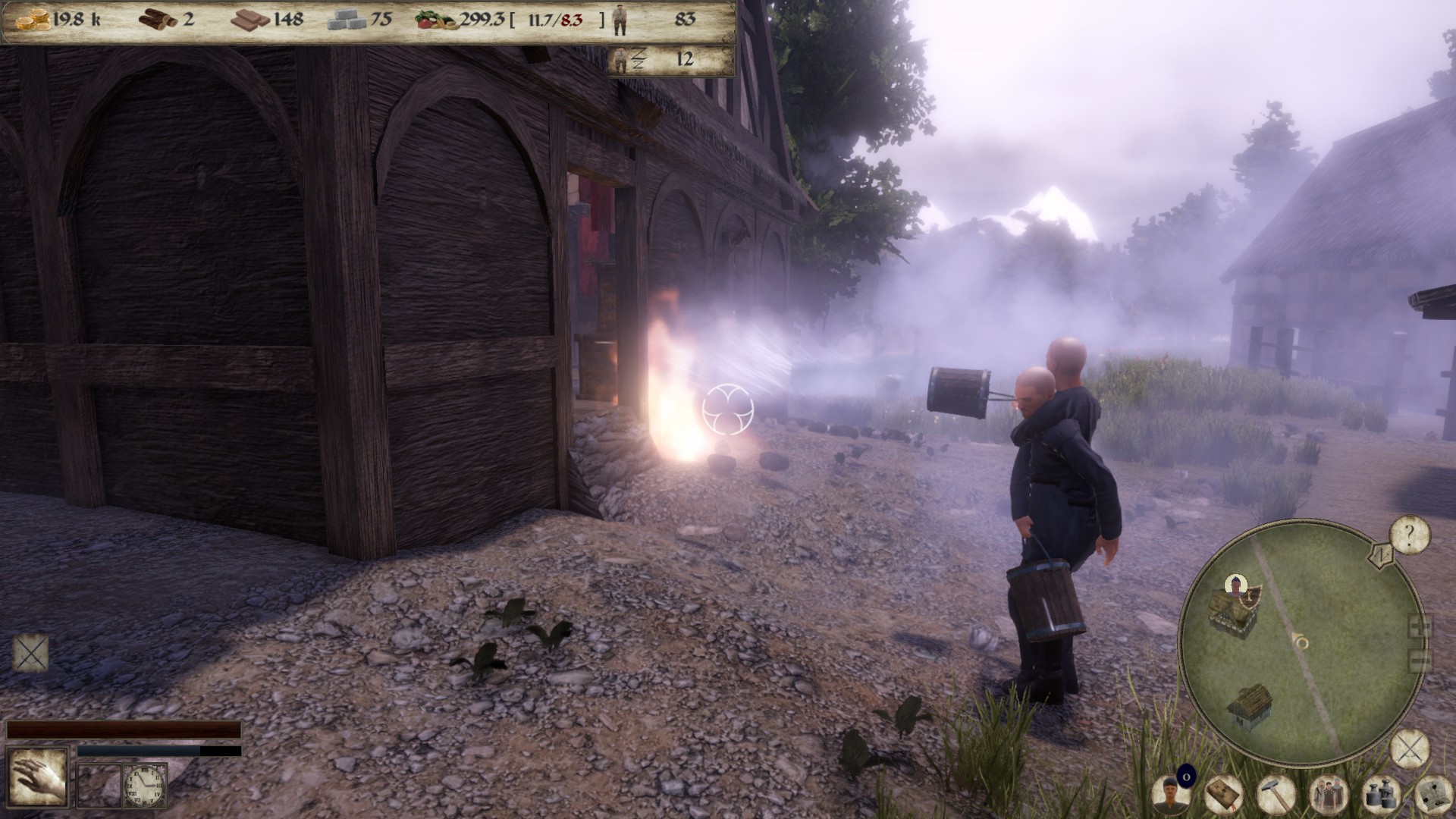
What came as a bit of a surprise (and perhaps shouldn’t have) is how noticeably the buildings change in appearance each time you upgrade them. Houses gain floors and are made from different materials; production buildings get extra rooms; open pits get covered spaces; and existing rooms extend. Even more important, they gain hit points behind the scenes, which makes them a lot more resistant to damage — good to hear considering how much work some take to build.
If you’re even a tiny bit up on history, you might recall that the medieval period (as with much of human history, to be fair) came with a fair amount of people biffing each other for land, resources and minor disagreements. Then it comes as no surprise that Empires and Tribes includes military aspects. You can build your own keep and add bits to it as you go along, such as quarters for archers and stables, as well as towers and walls. This, along with more production buildings, lets you train your own soldiers. You can garrison some of your archers to any towers you build, but the rest will mill around with the rest of the soldiery until you assign them to an army.
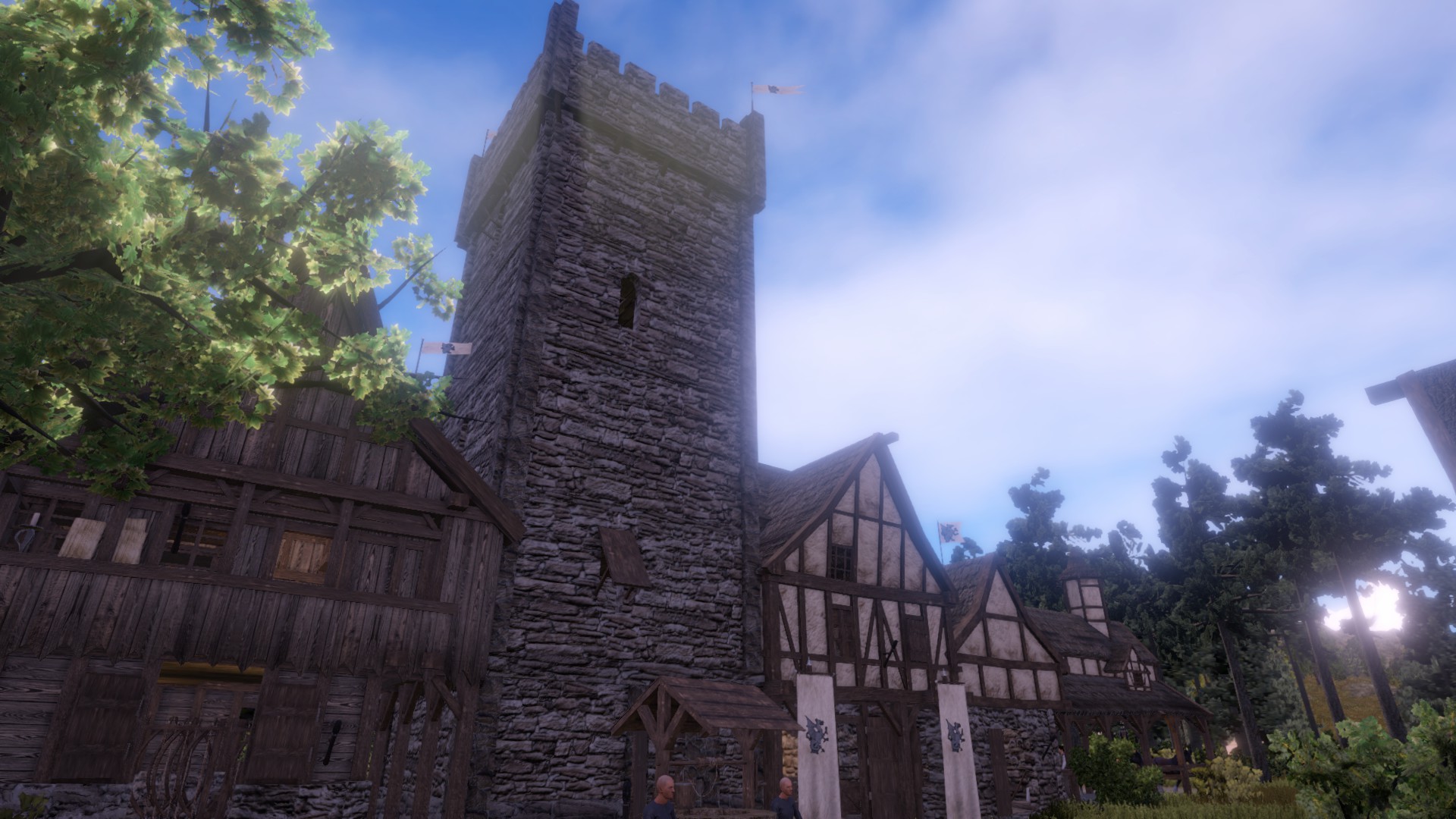
Armies come with their own special command UI, where you can either use multi-select or click on the army icon to issue orders to all your troops at once. Unfortunately, you can’t just ask them to patrol the town and you don’t have town guards, so when you come under attack, you’re left trying to work out where the attackers are, find them on foot and command your army all at once. During these attacks, you can talk to soldiers directly to command them to attack the nearest enemies, but all that seemed to do was send them a few metres further away to mill around in excitement. This may be because the only attacks we encountered coincided with ‘thief’ events, and in fact the thief may have counted as an attack. To date, we have never caught the thief red-handed. It isn’t all too clear where to look or what to look for, but our consolation is that thefts don’t make any considerable dent in our impressive money pile. We hope the command interface will see improvements in future — setting patrol routes or just letting troops wander the city at will would be great additions.
On the less human side of problems that could affect your town, you have storms. Big, rolling storms that fest over your town and lash down with lightning. At first, it was just impressive — Empires and Tribes’ environmental graphics can be quite beautiful — but then we realised lightning could really strike. Of course, this starts fires, and if you haven’t crafted yourself a bucket by this point, all you can do is run around watching your citizens deal with it. This is where the wells you have to build come in — for a long time, we thought the random blokes who sat on the stool next to each well were purely cosmetic, but it turns out they’re firemen. When lightning strikes, they ferry bucketloads of water between the well and the fire until it’s out. On low-level buildings, they often can’t do much to help. You would probably need to help out yourself with a bucket. We tried to craft one, but couldn’t work out how to harvest the required fibre after trying a few bushes, trees and bits of undergrowth.

Empires and Tribes has a lot going for it in terms of concept. As it stands, it’s buggy, which is to be expected to a certain extent in an early access title, but you may want to wait and keep an eye on it if you’re looking for a more stable experience. I can’t walk into my weaponsmith without falling through the floor, but infinite freefall is at least recoverable via the settings menu. My workers sometimes forget where their workplaces are and lose their jobs, but they remember after a little while. As with many (perhaps too many) games, its UI could use a heap of love and feedback. But what there is so far is satisfying, and the way ahead is full of promise for a polished release.
Comments are closed.